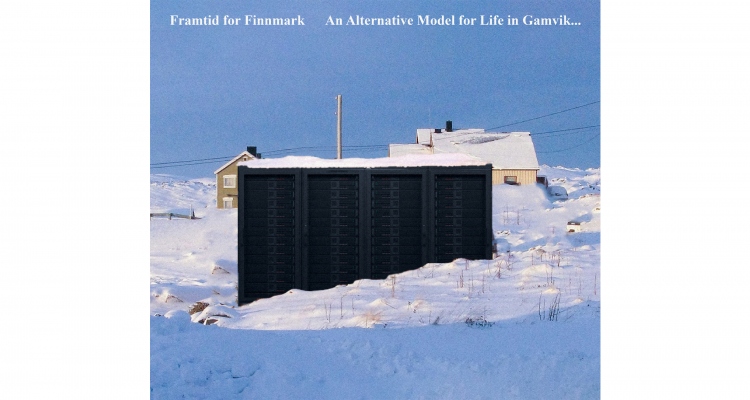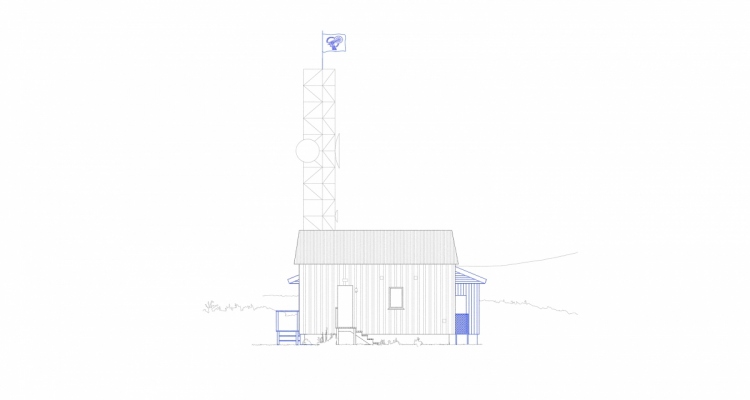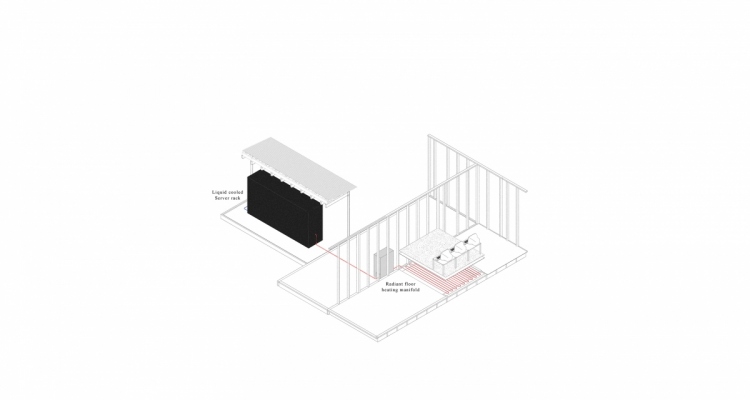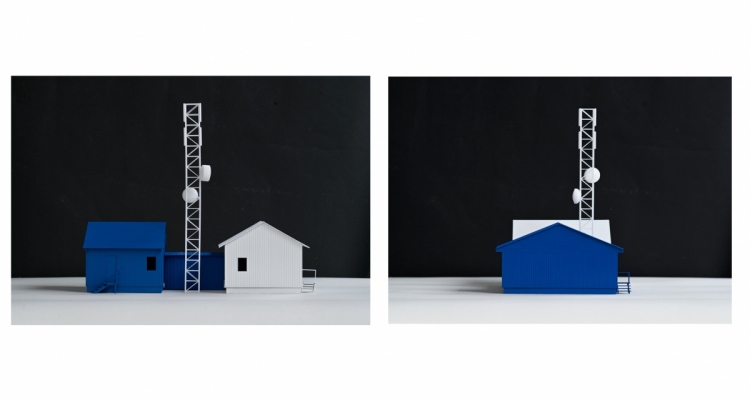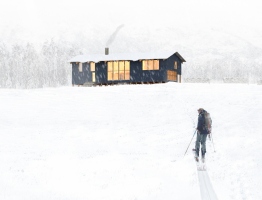Diplomprosjekt
Høst 2021
Institutt for arkitektur
“For things to remain the same, everything must change”
- Giuseppe Tomasi di Lampedusa, The Leopard. 1960
At the end of World War II, the region of Finnmark was systematically destroyed by retreating Wehrmacht forces. The entire population was forcefully evacuated, and all built structures were burnt to the ground. Immediately following the war, a reconstruction of the region began. The reconstruction brought with it a new model for life in Finnmark, rooted in the ideals of social democracy and modernisation. Through a great effort, this model was implemented throughout the region in record time. Continued state intervention during the 1960s and decentralisation policies during the 1970s helped keep the welfare state institutions, and thus the post-war model, intact. Through a continued dismantling of the welfare state following the 1980s, the post-war model has become antiquated and unreliable. In Finnmark, the tendency of corporatisation and centralisation has resulted in a series of continuous crises of unemployment and population decline.
For many, the solution seems to lie in a reestablishment of industry and institutions, following the welfare model. This project is an attempt at looking the other way - towards the future, instead of the past. The aim of the project is to imagine a way out of the downward spiral by following the trajectory of modernisation through to its conclusion, rather than trying to cling on to the past. The project asks: Is it time for a second reconstruction?
Due to the continued process of liberalisation since the 1950s, it is hard to imagine a state funded reconstruction effort could take place today. Because of this, the project is therefore an attempt at staging a reconstruction on a micro-scale, with individual and community action as a driving force. Not only does this appear as one of few viable options, it also limits the consequences of its potential failure. The radical shift brought on by the post-war reconstruction and the devastating consequence of its dismantlement proves an important lesson in this regard. Unlike the ideologically charged post-war reconstruction, the proposed second reconstruction is not an attempt at presenting a ‘final’ vision for Gamvik, but focuses on important first steps in the process of transcending the post-war model.
The post-war model may be antiquated, but its structures still remain. In Finnmark, this is especially true due to the structure of the Norwegian housing market. In a region where the market price rarely exceeds the value of the built structure itself, constructing new houses makes little sense. The project therefore focuses on transformation and additions to existing structures through a Do-It-Yourself approach. The DIY aspect is vital to minimising the cost of the proposed structures, and also contributes to the continuation of a tradition of DIY improvement.Playing further on the continuation of tradition, the ideal of the fisherman-farmer is an important aspect of the project. The traditional North-Norwegian model of subsistence farming coupled with periods of paid labor presents an intriguing alternative to the permanently employed wage labourer of the post-war era, and stands as a symbol of self-reliance and resiliency.
The project is comprised of three parts, each addressing a specific topic related to an overall theme: The implementation of new technology in order to maintain a traditional way of life:
The first deals with the internet as a commons - a resource equally accessible to all members of a society.
The second deals with the utilisation of the home as a means of income.
The third deals with the potential of further decentralisation by expanding connection possibilities.
The project is equally utopian and reactionary. Utopian in the sense that it maintains a belief in the revolutionary and liberating potential of new technology, reactionary in the sense that it views the post-warmodel/modernisation as a ‘break’ with tradition, idealising instead a traditional, place-specific way of life.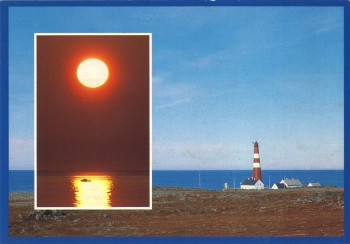
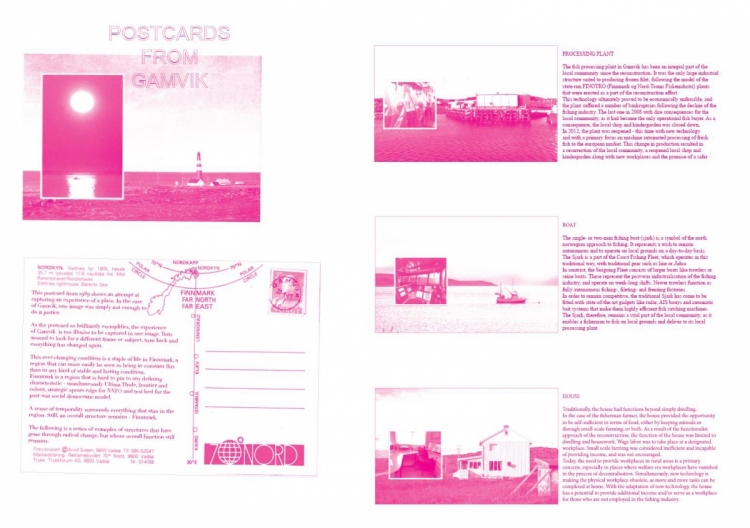
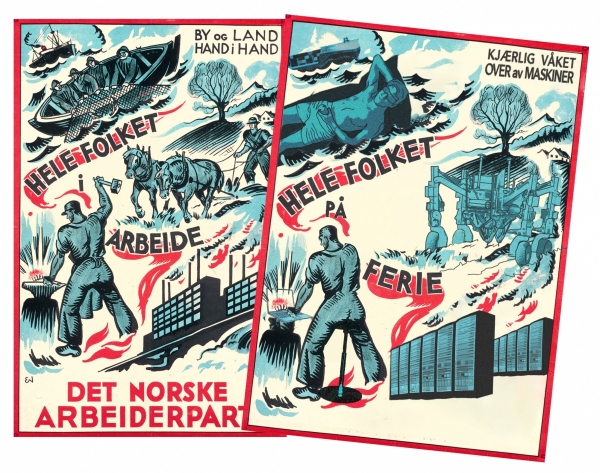
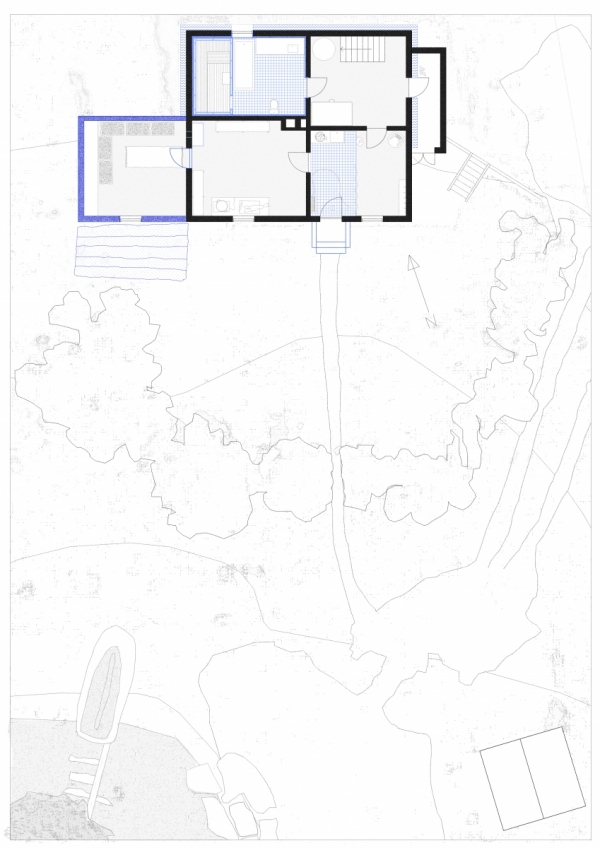
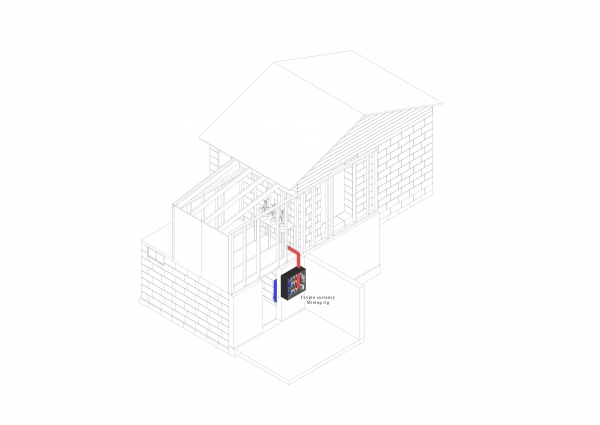
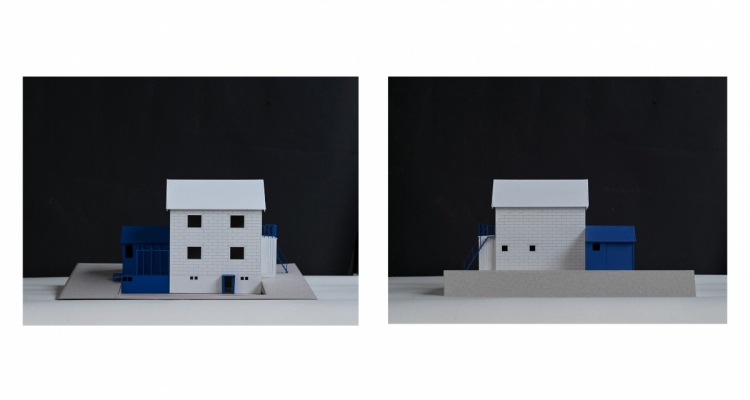
Nothing but Net
In the beginning phases of the reconstruction, many of the places were deemed unfit for modernisation, and were not intended for reconstruction. This was a strategy founded in rational principles, as the intended shift towards industrialisation of the fisheries required a higher degree of centralisation.
Only due to the act of civil disobedience enacted by the evacuated population, returning home in droves before restrictions on returning were lifted, were these places ever reconstructed. Since then, a continuous trend of centralisation has rendered many of these places uninhabitable, or rather incompatible with the common structuring of work.
Through the erection of a new telecommunications mast on the outskirts of Gamvik, the project tries
to provide an opportunity to counter the trend of decentralisation by providing high-speed internet connection to settlements in the outskirts. The mast allows remote areas to connect to the GCC servers. The mast is located on one of two points in Gamvik which is capable of receiving and transmitting a 5g signal.
Through a fencing in, the immaterial nature of this connection point is given a physical dimension. The fence is set up as a shelter for the harsh weather coming in from the sea, and thereby facilitates plant growth within its border. On the more protected west facing side, the stone fence is replaced by a planted row of Monkshood flowers: A bright blue, poisonous growth that is used locally as a preventive measure towards reindeer grazing

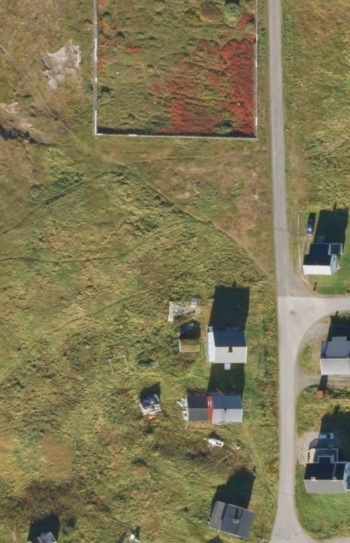

- Giuseppe Tomasi di Lampedusa, The Leopard. 1960
At the end of World War II, the region of Finnmark was systematically destroyed by retreating Wehrmacht forces. The entire population was forcefully evacuated, and all built structures were burnt to the ground. Immediately following the war, a reconstruction of the region began. The reconstruction brought with it a new model for life in Finnmark, rooted in the ideals of social democracy and modernisation. Through a great effort, this model was implemented throughout the region in record time. Continued state intervention during the 1960s and decentralisation policies during the 1970s helped keep the welfare state institutions, and thus the post-war model, intact. Through a continued dismantling of the welfare state following the 1980s, the post-war model has become antiquated and unreliable. In Finnmark, the tendency of corporatisation and centralisation has resulted in a series of continuous crises of unemployment and population decline.
For many, the solution seems to lie in a reestablishment of industry and institutions, following the welfare model. This project is an attempt at looking the other way - towards the future, instead of the past. The aim of the project is to imagine a way out of the downward spiral by following the trajectory of modernisation through to its conclusion, rather than trying to cling on to the past. The project asks: Is it time for a second reconstruction?
Due to the continued process of liberalisation since the 1950s, it is hard to imagine a state funded reconstruction effort could take place today. Because of this, the project is therefore an attempt at staging a reconstruction on a micro-scale, with individual and community action as a driving force. Not only does this appear as one of few viable options, it also limits the consequences of its potential failure. The radical shift brought on by the post-war reconstruction and the devastating consequence of its dismantlement proves an important lesson in this regard. Unlike the ideologically charged post-war reconstruction, the proposed second reconstruction is not an attempt at presenting a ‘final’ vision for Gamvik, but focuses on important first steps in the process of transcending the post-war model.
The post-war model may be antiquated, but its structures still remain. In Finnmark, this is especially true due to the structure of the Norwegian housing market. In a region where the market price rarely exceeds the value of the built structure itself, constructing new houses makes little sense. The project therefore focuses on transformation and additions to existing structures through a Do-It-Yourself approach. The DIY aspect is vital to minimising the cost of the proposed structures, and also contributes to the continuation of a tradition of DIY improvement.Playing further on the continuation of tradition, the ideal of the fisherman-farmer is an important aspect of the project. The traditional North-Norwegian model of subsistence farming coupled with periods of paid labor presents an intriguing alternative to the permanently employed wage labourer of the post-war era, and stands as a symbol of self-reliance and resiliency.
The project is comprised of three parts, each addressing a specific topic related to an overall theme: The implementation of new technology in order to maintain a traditional way of life:
The first deals with the internet as a commons - a resource equally accessible to all members of a society.
The second deals with the utilisation of the home as a means of income.
The third deals with the potential of further decentralisation by expanding connection possibilities.
The project is equally utopian and reactionary. Utopian in the sense that it maintains a belief in the revolutionary and liberating potential of new technology, reactionary in the sense that it views the post-warmodel/modernisation as a ‘break’ with tradition, idealising instead a traditional, place-specific way of life.



The global system of interconnected computer network resources belong to society as a whole
The telecommunications base station serves an important function in Gamvik, providing the village with a reliable telephone and internet connection.It is located only a stone’s throw away from the school, the local shop and community house, but serves no other function than providing shelter for the telecommunications equipment and its up-keepers.
With the purpose of maintaining the internet as a commons and countering the trend towards corporatisa-tion of the www, the telecommunications base station receives an addition in the form of a server room. The servers are run and maintained by the Gamvik Computer Club, an organisation devoted to the decor-poratisation of the internet. The servers provide storage for Gamvik’s inhabitants, and serve as the frame-work for creating local alternatives to dominant corporate web services like Facebook or YouTube.
The new structure leeches on to the existing base station, taking advantage of existing water, power and restroom functions. In addition to serving as the headquarters of GCC, the new structure functions as a micro youth centre, equipped with a high speed, low-latency internet connection, heated wall-to-wall carpeting and a sofa. The hangout is accessible by a path leading directly to the school. Gamvik Computer Club is also responsible for publishing FRAMTID FOR FINNMARK, a fanzine that explores themes related to Finnmark, the future and the internet. Their printer is accessible to anyone already connected to the GCC servers, and can be used remotely.Prints will have to be picked up in person.
The server room is the heart of the new, decentralised and commonly accessible alternative to the existing www.
Homesteading on the electronic frontier
The reconstruction era house is a beacon of rationality, which radiates from its construction principle, through its plan layout and out unto its facade and character. Rationalisation of housing comes with a price, however - it requires a subject to whom the organisation is rational. While relevant during the 1960s and -70s, the reconstruction house represents a break with the traditional organisation of a rural home
- from a common organisation principle, serving as an extension of workplace and/or farm to a more bourgeois principle -introducing rooms with specialised, and thus limited, functions.
With the emergence of the home office and alternative modes of employment introduced through
the internet, the traditional, or common, differentiation of the house is increasingly relevant. The transformation of the single family house is an attempt to reintroduce the multi-functionality of the house, allowing it to provide subsistence in form of both food and income.
The house in question is located on a relatively traditional plot, with direct access to both the sea and the road. This time around, however, the roles are reversed - the sea provides food and the house provides income. In addition to fishing, the possibility of growing and storing potatoes and other vegetables is reintroduced, and an additional greenhouse provides the opportunity to grow non-regional produce. The greenhouse is heated with hot air, a byproduct of a cryptocurrency mining rig cooling system. The rig generates both heat and income when electricity prices are low.
The telecommunications base station serves an important function in Gamvik, providing the village with a reliable telephone and internet connection.It is located only a stone’s throw away from the school, the local shop and community house, but serves no other function than providing shelter for the telecommunications equipment and its up-keepers.
With the purpose of maintaining the internet as a commons and countering the trend towards corporatisa-tion of the www, the telecommunications base station receives an addition in the form of a server room. The servers are run and maintained by the Gamvik Computer Club, an organisation devoted to the decor-poratisation of the internet. The servers provide storage for Gamvik’s inhabitants, and serve as the frame-work for creating local alternatives to dominant corporate web services like Facebook or YouTube.
The new structure leeches on to the existing base station, taking advantage of existing water, power and restroom functions. In addition to serving as the headquarters of GCC, the new structure functions as a micro youth centre, equipped with a high speed, low-latency internet connection, heated wall-to-wall carpeting and a sofa. The hangout is accessible by a path leading directly to the school. Gamvik Computer Club is also responsible for publishing FRAMTID FOR FINNMARK, a fanzine that explores themes related to Finnmark, the future and the internet. Their printer is accessible to anyone already connected to the GCC servers, and can be used remotely.Prints will have to be picked up in person.
The server room is the heart of the new, decentralised and commonly accessible alternative to the existing www.
Homesteading on the electronic frontier
The reconstruction era house is a beacon of rationality, which radiates from its construction principle, through its plan layout and out unto its facade and character. Rationalisation of housing comes with a price, however - it requires a subject to whom the organisation is rational. While relevant during the 1960s and -70s, the reconstruction house represents a break with the traditional organisation of a rural home
- from a common organisation principle, serving as an extension of workplace and/or farm to a more bourgeois principle -introducing rooms with specialised, and thus limited, functions.
With the emergence of the home office and alternative modes of employment introduced through
the internet, the traditional, or common, differentiation of the house is increasingly relevant. The transformation of the single family house is an attempt to reintroduce the multi-functionality of the house, allowing it to provide subsistence in form of both food and income.
The house in question is located on a relatively traditional plot, with direct access to both the sea and the road. This time around, however, the roles are reversed - the sea provides food and the house provides income. In addition to fishing, the possibility of growing and storing potatoes and other vegetables is reintroduced, and an additional greenhouse provides the opportunity to grow non-regional produce. The greenhouse is heated with hot air, a byproduct of a cryptocurrency mining rig cooling system. The rig generates both heat and income when electricity prices are low.



Nothing but Net
In the beginning phases of the reconstruction, many of the places were deemed unfit for modernisation, and were not intended for reconstruction. This was a strategy founded in rational principles, as the intended shift towards industrialisation of the fisheries required a higher degree of centralisation.
Only due to the act of civil disobedience enacted by the evacuated population, returning home in droves before restrictions on returning were lifted, were these places ever reconstructed. Since then, a continuous trend of centralisation has rendered many of these places uninhabitable, or rather incompatible with the common structuring of work.
Through the erection of a new telecommunications mast on the outskirts of Gamvik, the project tries
to provide an opportunity to counter the trend of decentralisation by providing high-speed internet connection to settlements in the outskirts. The mast allows remote areas to connect to the GCC servers. The mast is located on one of two points in Gamvik which is capable of receiving and transmitting a 5g signal.
Through a fencing in, the immaterial nature of this connection point is given a physical dimension. The fence is set up as a shelter for the harsh weather coming in from the sea, and thereby facilitates plant growth within its border. On the more protected west facing side, the stone fence is replaced by a planted row of Monkshood flowers: A bright blue, poisonous growth that is used locally as a preventive measure towards reindeer grazing



